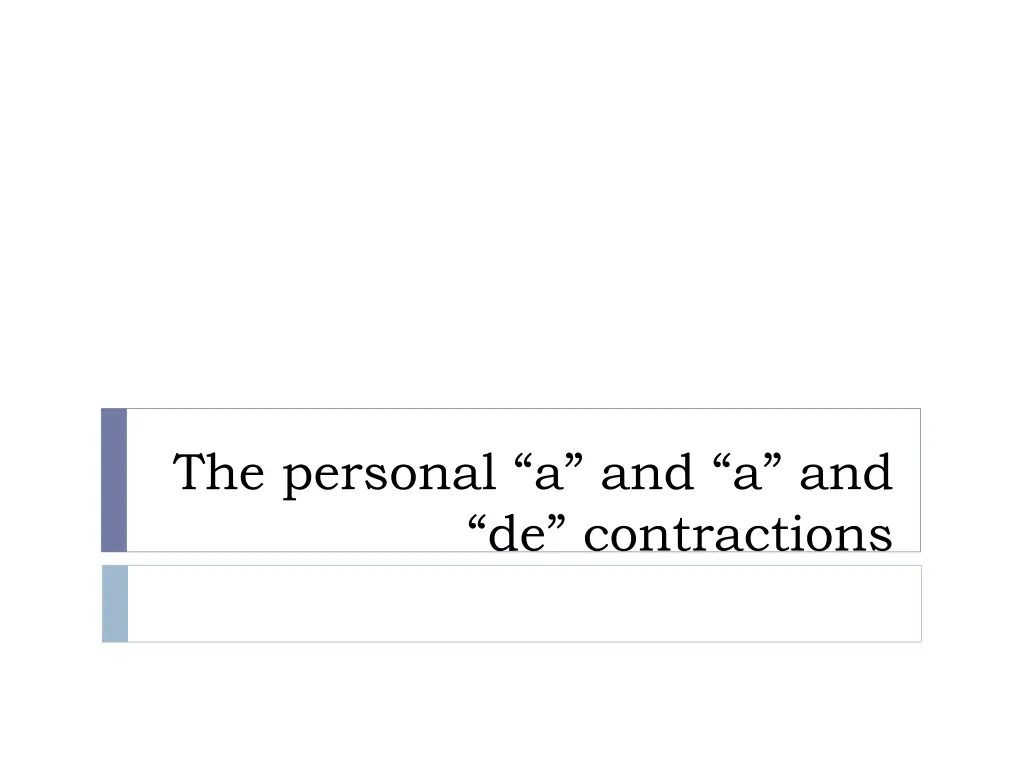
Spanish Sentence Structure and Personal "a" in Spanish
Understand the structure of Spanish sentences with a subject, verb, and object. Learn about the personal "a" used when the object is a person, common verbs where people can be objects, and exceptions to using the personal "a" in sentences. Explore examples and contractions like "a" and "de" in Spanish.
Uploaded on | 0 Views
Download Presentation

Please find below an Image/Link to download the presentation.
The content on the website is provided AS IS for your information and personal use only. It may not be sold, licensed, or shared on other websites without obtaining consent from the author. If you encounter any issues during the download, it is possible that the publisher has removed the file from their server.
You are allowed to download the files provided on this website for personal or commercial use, subject to the condition that they are used lawfully. All files are the property of their respective owners.
The content on the website is provided AS IS for your information and personal use only. It may not be sold, licensed, or shared on other websites without obtaining consent from the author.
E N D
Presentation Transcript
The personal a and a and de contractions
Elements of Spanish Sentences Spanish sentences, like English ones contain a subject, a verb and an object. Yo escucho la radio S V O Mi amigo come papas fritas. Tomamos vino por la ma ana.
La a personal The personal a is used when the object of a Spanish sentence is a person or persons. There is no equivalent in English. Llamo a mi amiga. Invitamos a Celia a la fiesta. Juana escribe una carta a Juanita.
Common Verbs where people can be objects. Llamar Llevar Invitar Escribir Conocer Ver Amar Hablar Mandar/enviar Dar To call (someone) To take (someone somewhere) To invite (someone) To write (someone something) To know (someone) To see (someone) To love (someone) To talk (to someone)* To send (someone something) To give (someone something)
The personal a is not used When the object of the sentence is not human Karla lleva los libros a la biblioteca Karla is taking the books to the library. Karla lleva a su hermana a la biblioteca. Karla is taking her sister to the library.
Neither is it used with the verbtener Tengo muchos amigos. I have many friends Llevo a mis amigos al cine. I take my friends to the movies. Juan tiene cinco novias. Juan has five girlfriends. Juan invita a sus novias a comer en McDonalds porque no tiene dinero Juan invites his girlfriends to eat at McDonalds because he doesn t have money.
If the objects of the sentence include several individual people, the a is placed before each one. Juan invita a Mar a,a Claudia,a Sof a, a Isabel y a Rosita Chiquita a comer en McDonalds. Juan invites Maria, Claudia, Sophia, Isabel and Rosita to eat at Mc Donalds.
A, De and Contractions A A can be used either as the personal a or the preposition to or towards . When a comes before the article el , they contract to form al . Llamo al (a + el) doctor. I m calling the doctor Llevo a mi amiga al cine. I m taking my friend to the movies..
De De can be used as the possessive de or the preposition of/from Similarly when de comes before the article el they contract to form del Vengo del club I m coming from the club. La esposa del profesor es muy guapa. The professor s wife is very beautiful
De and A do not contract with la, los or las. Conozco a la mam de mi amigo. I know my mom s friend. Vamos a los juegos ol mpicos. We re going to the Olympic Games. De and A also do not contract with the subject pronoun l: Recibo una carta de l
